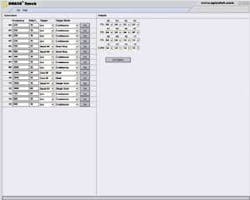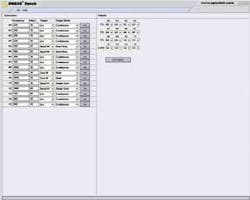Vision system synchronizes multiple high-speed cameras
Andrew Wilson, Editor, [email protected]
Many machine-vision systems deployed in industrial applications require numerous high-speed digital cameras to continuously monitor the quality of products at various stages in the production process. To trigger these cameras, system integrators often use external photoelectric sensors interfaced directly to cameras or frame grabbers. Once an external trigger event is made, the rate of the production line can be used to synchronize many cameras without further external triggering.
In more sophisticated systems, multiple external triggers may be required to synchronize an even larger number and variety of cameras at different frame rates. Such systems could, for example, be used to capture large monochrome or color images at 30 frames/s at one stage of production and lower-resolution images at 500 frames/s at other stages.
“When developing these systems,” says Mikael Brommels, president of Spica Technology (Maui, HI, USA; www.spicatek.com), “system integrators must properly trigger and synchronize every camera using numerous external sensors, cameras and frame grabbers.” To do this cost-effectively, a number of frame-grabber vendors now offer dual Base Camera Link frame grabbers that can interface two digital cameras to a single PCI or PCI Express add-in board. While such dual inputs may allow different cameras to be interfaced simultaneously to the frame grabber, many boards only offer single sync and trigger signals.
“Thus,” says Brommels, “both cameras must be triggered from the same event and synchronized to run at the same speed.” To overcome this, manufacturers, including Spica Technology, offer external synchronization and digital I/O devices that allow multiple cameras to be triggered on disparate events while each camera is clocked at different frequencies.
At the recent Defense & Security Symposium (April 2006; Orlando, FL, USA), Spica showed how its Synch/Box could be used in such a manner to control up to 16 Camera Link cameras running at 16 independent clocks triggered from different sources. In that system, two 640 × 480 VGA 210 Camera Link cameras from Imperx (Boca Raton, FL, USA; www.imperx.com) were interfaced to a PC using an R64-CL Camera Link frame grabber from Bitflow (Woburn, MA, USA; www.bitflow.com) running in dual-Base mode (see figure).
To trigger each of the cameras independently, Spica’s Synch/Box was mounted inside a 5.25-in. bay within a dual 3-GHz Xeon PC-based server. “Using the Synch/Box,” says Brommels, “four independent user-programmable synchronization frequencies between 0 and 5 MHz can be used to control up to 16 cameras in 0.01-Hz steps. Thus, it is possible to control 16 different cameras with four groups of four cameras running at different speeds. And, because the Synch/Box can receive external triggers from four separate sources, each group of four cameras can be controlled with a different external trigger. This allows sophisticated, multicamera systems to be built using a minimum number of frame grabbers, digital I/O, and triggering hardware.
“For the system integrator building high-speed data-acquisition and motion-capture systems,” says Brommels, “this is especially, useful since these systems often require multiple, independently clocked and triggered camera data to be rapidly digitized.”
To support the hardware, Spica offers two PC-based software packages. The first, DMAS6, is a digital high-speed recording package that supports automatic or manual tracking with subpixel accuracy. Supporting Camera Link, LVDS EIA-644, or RS-422 progressive-scan digital cameras from companies such as Adimec (Eindhoven, The Netherlands; www.adimec.com), Basler (Ahrensburg, Germany; www.baslerweb.com), DALSA (Waterloo, ON, Canada; www.dalsa.com), and others, the software can manage video, stills, audio, analog, and digital inputs; GPS information; and IRIG-B time-synchronization data.
As part of DMAS6, the company’s IDAS high-speed data-acquisition software can record information at up to 250 Mbytes/s sustained using the PCs SCSI channel cluster unit and store up to 5 Tbytes of image data per camera using lossless or lossy compression techniques.

